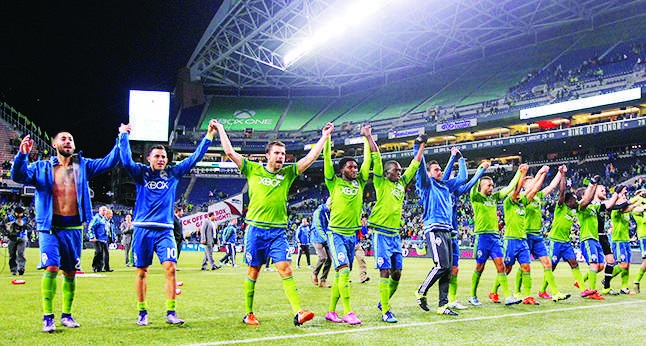
By Danny Rust
The 2015 Major League Soccer season ended in, arguably, the best way possible – with a franchise winning the MLS Cup for the first time in their short history.
The Portland Timbers, led by former Premier League defender Liam Ridgewell (currently on loan at Brighton), beat Columbus Crew 2-1 to claim their first crown since being founded only six years ago.
That win brought the curtain down on Major League Soccer’s 20th season, and the competition has been on a rollercoaster ride since it was established in 1996.
Rebooting the beautiful game in the USA – following the demise of the North American Soccer League in 1984 – was a condition of the USA’s successful bid to host the 1994 FIFA World Cup.
The inception of MLS did not actually come about until two years after the tournament had passed through the country for the first time.
Originally, the league struggled to get off the ground as broadcasters were more interested in broadcasting the more traditional American sports of American Football, baseball, basketball and ice hockey, while investors and sponsors were not forthcoming either.
MLS’ first five years were grim. Collective losses of $250m (£180m) were recorded and franchises were playing in not even half-full NFL arenas, rather than purpose-built soccer stadiums.
But now, after the climax of its 20th campaign, MLS is more popular than ever. The Seattle Sounders finished the season with an average attendance of 45,000 and the Washington State-based side has sold out the last 126 games at CenturyLink Field, which is shared with NFL giants the Seattle Seahawks. Orlando City, which became MLS’ 20th side at the start of the 2015 season, recorded average gates of more than 32,000, while fellow expansion side New York City FC were not much further behind in terms of support.
In fact, MLS’ average attendance for 2015 was 21,574. That is a higher average than that of France’s top division – Ligue One.
MLS’ average attendance figures have constantly risen since 2006, when the average gate was just over 15,000.
It’s set to reach a wider audience too, as four more expansion sides are due to join the USA’s elite division.
Atlanta United will become MLS’ 21st franchise in 2017, while Los Angeles FC will replace the now defunct Chivas USA a year later. (Florida sides Miami Fusion and Tampa Bay Mutiny are the only other teams to drop out of MLS since the league’s establishment.)
Meanwhile, Minnesota United will come into MLS at a later date, and David Beckham’s Miami franchise will be welcomed into the league once he finds a suitable plot of land to build a stadium.
MLS is unique. In fact, Major League Soccer commissioner Don Garber describes it as “the most intriguing, head-scratching league in world football”. Garber has been the head of MLS since 1999, having left a job in the NFL. He has taken MLS from strength to strength and seen the competition grow over time. Just one example of growth is that this was the first season matches were televised globally.
MLS is dissimilar to any other football league. The league functions as a single entity, with ‘operator-investors’ running franchises. There is no promotion or relegation as the drop would be bad for business. A franchise could finish top of their respective Conference and yet fail to win the MLS Cup due to the play-offs system. There is a salary cap in place, as well as a Draft at the start of every campaign, with the goal being to promote a competitive balance between teams.
Franchises are now allowed designated players, with Beckham being the most obvious example. The former England international captain joined LA Galaxy on a salary of $6.5m in 2007.
His former England team-mate Steven Gerrard and Robbie Keane have swapped the Premier League for California in recent years, and they account for 55 per cent of the Galaxy’s pay roll. The wages these players earn are in stark contrast to the average MLS salary of £187,000.
The standard of play has improved dramatically since MLS was created in 1996, with Garber comparing the league to the Sky Bet Championship.
The progression now sees football legends, admittedly most past their peak, move to the United States, and some of the world’s best teams, including Bayern Munich and Manchester United, travel across the pond for pre-season friendlies against MLS sides, or to face the MLS All-Stars – a game which is contested once a year.
Some suggest that footballers move Stateside, salaries withstanding, because the standard is worse and it is not so gruelling. But the competition spans two countries and four different time zones, which can affect the players. Travel times are lengthy, with LA Galaxy having to endure a six-hour flight to take on Orlando City at the Citrus Bowl in Florida.
An exciting part of MLS is that it is unpredictable. The final four franchises fighting it out for the MLS Cup this term were the Portland Timbers, Columbus Crew, New York Red Bulls and FC Dallas. Their sides did not boast the likes of Gerrard, Keane, Giovani Dos Santos (all LA Galaxy), Frank Lampard, Andrea Pirlo (both New York City), Sebastian Giovinco (Toronto) or Kaka (Orlando City).
However, the fact that franchises are able to attract these stars shows how far this league has come in such a short space of time.
Furthermore, the fact that none of these legends won the MLS Cup shows the league is not as easy as it may appear.
Gerrard didn’t win the MLS Cup. Nor did Lampard. But ex-Aston Villa, Birmingham and West Brom defender Ridgewell did. That shows the unpredictability of the MLS – and long may it


Book Reviews
Book Review: Chris Towers finds right mix

Book Reviews
Book Review: Sir Geoff Hurst hits net











